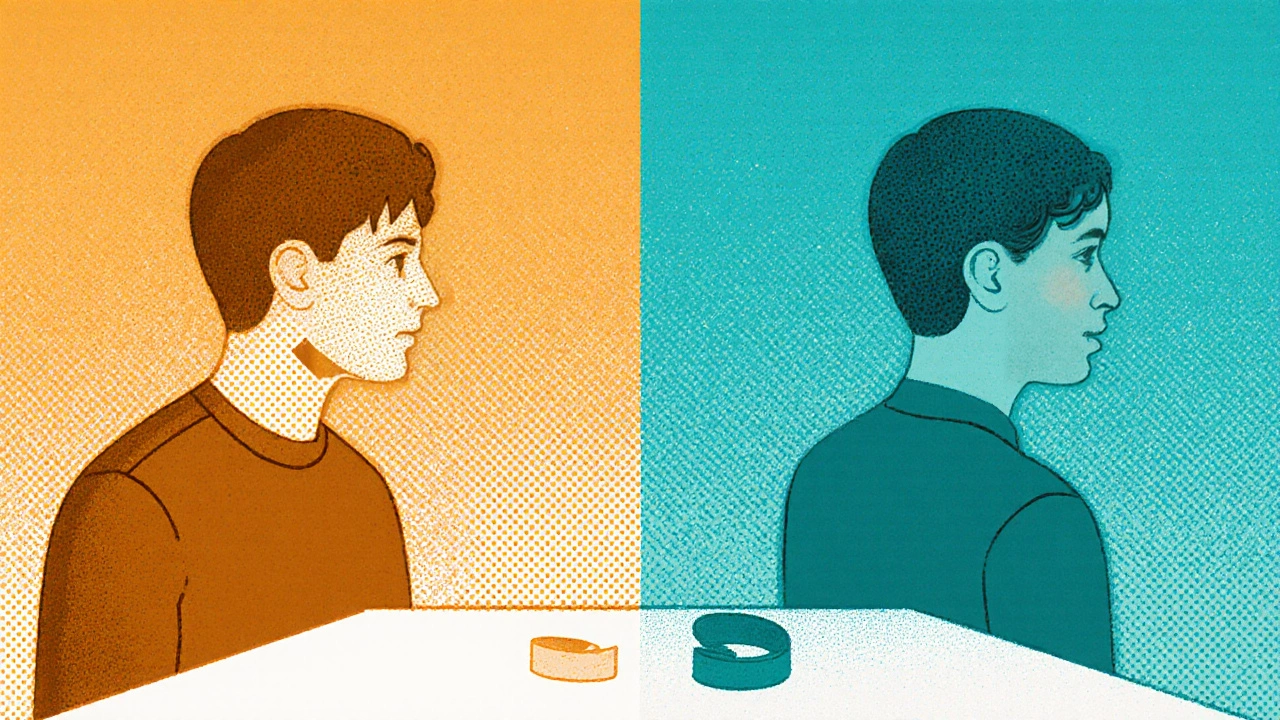Neck pain isn't just an annoyance-it can stop you from turning your head, sleeping comfortably, or even focusing at work. If you've woken up with a stiff neck after sleeping wrong, or felt a sharp ache after a car ride or phone slump, you're likely dealing with cervical strain. This isn't a mysterious condition. It's a common muscle and tendon injury in your neck, and the good news? Most cases heal quickly with the right approach.
What Exactly Is Cervical Strain?
Cervical strain happens when the muscles, tendons, or ligaments in your neck get stretched or torn. It’s not a fracture or a pinched nerve. It’s soft tissue damage. Think of it like pulling a hamstring, but in your neck. The most common culprits? Sitting hunched over a laptop, sudden jerks from a car accident (whiplash), holding your phone between your ear and shoulder, or sleeping in an awkward position. According to the American Association of Neurological Surgeons, cervical strain accounts for 60-70% of all neck pain cases seen by doctors. That’s more than half. And it’s not just older adults-people aged 35 to 54 are most affected, especially office workers. One study found office employees are 2.3 times more likely to get it than manual laborers, simply because they sit still for hours with their heads tilted forward. The pain usually shows up fast. You might feel it right after the injury, or wake up with it the next morning. The most common symptoms? Localized pain in the neck (reported in 92% of cases), stiffness (87%), tenderness when you touch the area (78%), and trouble turning your head (73%). Pain often spikes when you look up or side-to-side. On a scale of 1 to 10, most people rate it between 4 and 6 during the first few days.How Is It Different From Other Neck Problems?
Not all neck pain is the same. It’s easy to confuse cervical strain with other issues, but the differences matter for treatment. If your pain shoots down your arm, or you feel numbness or tingling in your fingers, that’s likely cervical radiculopathy-a pinched nerve. That’s different from strain, where pain stays in the neck and shoulders. If you’re over 60 and your neck has been aching slowly for months, with a grinding feeling when you move, it could be osteoarthritis. That’s wear-and-tear on the joints, not a sudden injury. And if your neck feels stiff all day, especially in the morning, and stays stiff for more than 30 minutes, it might be rheumatoid arthritis, an autoimmune condition. Cervical strain has a clear pattern: pain gets worse with movement, better with rest. It doesn’t cause weakness, numbness, or balance problems. If you have those, see a doctor right away.How Long Does It Take to Heal?
Recovery time depends on how bad the strain is. - Mild strain: Tiny tears in muscle fibers. Pain fades in 2-3 days. You might feel a little stiff, but daily activities are fine. - Moderate strain: Partial tearing. Pain lasts 1-2 weeks. Movement is limited, and you might need to ease back into normal activity. - Severe strain: Complete tear of a muscle or tendon. Recovery takes 6-12 weeks. This is rare without trauma like a car crash. The key? Don’t stay still too long. Studies show that resting for more than 72 hours slows recovery by 37%. Your neck needs gentle movement to heal properly.
What Works: Evidence-Based Treatment
There’s a lot of noise out there-chiropractic adjustments, miracle creams, neck braces you wear 24/7. But what actually helps? Here’s what the science says.First 72 Hours: Rest and Ice
Don’t panic. Don’t reach for painkillers immediately. Start with relative rest-avoid heavy lifting, long phone calls, or staring at screens. Apply ice packs for 15-20 minutes every 2-3 hours. A 2022 study showed this cuts pain 32% more than just leaving ice on all day.Days 4-14: Move Gently
This is where most people go wrong. They wait too long to move. Start with simple exercises:- Chin tucks: Sit upright. Gently pull your chin straight back, like you’re making a double chin. Hold for 3 seconds. Repeat 10 times, 3 times a day.
- Scapular retractions: Sit or stand. Squeeze your shoulder blades together like you’re trying to hold a pencil between them. Hold 5 seconds. Repeat 10 times.
Weeks 3-6: Build Strength
Once the pain eases, it’s time to rebuild. Use resistance bands (like TheraBand®). Do two sets of 15 reps, three times a week. Focus on the muscles that stabilize your neck and shoulders-the lower trapezius and serratus anterior. One Reddit user, after six months of PT, reduced their forward head posture from 4.2 cm to 1.8 cm. Their daily headaches disappeared.Medications: Less Is More
Over-the-counter pain relievers like ibuprofen or acetaminophen can help in the first few days. But don’t keep taking them. The American Academy of Physical Medicine and Rehabilitation says NSAIDs (like Advil) beyond 7-10 days offer no extra benefit-and raise your risk of stomach problems by 15%. Acetaminophen works just as well for strain pain, with fewer side effects.Physical Therapy: The Gold Standard
If your pain lasts more than a week, see a physical therapist. A 2022 guideline from the American College of Physicians found that patients who started PT within 72 hours recovered 28% faster than those who waited. Physical therapists don’t just massage your neck. They fix posture, teach movement patterns, and target weak muscles. They also screen for psychological factors. If you’re catastrophizing your pain-thinking it’s worse than it is, or fearing movement will make it worse-you’re more likely to develop chronic pain. New guidelines now recommend cognitive-behavioral strategies for these cases.What Doesn’t Work (And Why)
Some treatments sound good but don’t deliver long-term results. - Neck braces: They feel supportive, but wearing them for more than a few days weakens your muscles. They’re only useful right after a serious injury. - Chiropractic adjustments: Many people feel better right after a crack or pop. That’s because it releases tension. But studies show the relief is often temporary. One survey found 32% of users needed repeated visits because the underlying issue-like poor posture-wasn’t fixed. - Massage alone: Feels nice, but doesn’t correct movement patterns. Combine it with exercise for real change.Prevention: Stop It Before It Starts
The best treatment is avoiding it altogether. - Fix your screen height: Your monitor should be at eye level. Use a laptop stand or books to raise it. - Take micro-breaks: Every 30 minutes, stand up, roll your shoulders, and do 3 chin tucks. - Strengthen your upper back: Push-ups, rows, and resistance band pulls help your posture more than you think. - Check your pillow: Your neck should stay aligned with your spine when sleeping. Side sleepers need a higher pillow. Back sleepers need one that supports the natural curve. A new FDA-approved device called NeckSense™ uses sensors to alert you when your head drifts forward. It’s not for everyone, but it’s a sign that tech is finally catching up to the problem.
When to See a Doctor
Most cervical strains heal on their own. But call a doctor if:- Pain lasts longer than 2 weeks despite home care
- You feel numbness, tingling, or weakness in your arms or hands
- You have trouble walking or balancing
- Pain wakes you up at night
- You’ve had a recent injury like a fall or car crash
Real Results, Real Timeline
Here’s what recovery looks like for most people:- Days 1-3: Rest, ice, avoid aggravating movements. Pain starts to ease.
- Days 4-7: Start gentle chin tucks and scapular retractions. Pain reduces by half.
- Week 2: Pain mostly gone. Full range of motion returns. Resume light activity.
- Week 3-4: Add resistance bands. Strength improves. No pain during daily tasks.
- Week 6: Back to normal. Prevention habits in place.
Final Thought
Cervical strain isn’t a sign of weakness. It’s a sign your body’s been pushed too far, too often. The solution isn’t a pill or a quick fix. It’s movement, awareness, and consistency. You don’t need expensive gear or weekly appointments. Just start small. Do three chin tucks while you brush your teeth. Adjust your monitor. Take a walk every hour. Your neck will thank you.How long does cervical strain usually last?
Most mild to moderate cervical strains resolve within 2 to 4 weeks. Mild cases improve in 2-3 days with rest and ice. Moderate strains take 1-2 weeks, and severe cases can take 6-12 weeks. Delaying movement beyond 72 hours can extend recovery by up to 37%.
Is neck pain from strain the same as a pinched nerve?
No. Cervical strain causes localized pain in the neck and shoulders without numbness or tingling. A pinched nerve (cervical radiculopathy) typically causes shooting pain, numbness, or weakness that travels down the arm, often past the elbow. If you feel these symptoms, see a doctor.
Should I use a neck brace for cervical strain?
Only for the first 24-48 hours after a sudden injury. Wearing a brace longer weakens neck muscles and delays healing. Most recovery comes from gentle movement, not immobilization. Avoid using braces as a long-term solution.
Is physical therapy worth it for neck strain?
Yes, especially if started within 72 hours of injury. Patients who begin physical therapy early recover 28% faster than those who wait. Therapy doesn’t just ease pain-it corrects posture, strengthens weak muscles, and reduces the risk of recurrence by up to 50%.
Can neck strain become chronic?
Yes, if not treated properly. About 10-15% of acute cases turn chronic, often because of poor posture, lack of movement, or ignoring early symptoms. People with forward head posture are 22% more likely to develop long-term pain. Early rehab and posture correction are the best ways to prevent this.
What’s the best sleeping position for neck strain?
Sleeping on your back with a pillow that supports your neck’s natural curve is ideal. Side sleepers need a pillow thick enough to keep the head aligned with the spine. Avoid sleeping on your stomach-it twists the neck and strains muscles. A pillow that’s too high or too flat can trigger or worsen strain.








11 comments
Sarbjit Singh
this post saved my life 🙏 i had neck pain for weeks and thought i needed surgery. did the chin tucks while brushing my teeth and boom-3 days later i can turn my head again. thanks for the simple advice!
Angela J
you know what they don't tell you? the government and big pharma are secretly funding those 'chin tuck' studies so you don't notice the 5G towers in your office are frying your cervical nerves. i tried ice... it made it worse. i think it's the fluoride in the water. 🤔
Sameer Tawde
just start small. 3 chin tucks while you brush. 10 seconds. that's it. no gear. no pills. no magic. just movement. your neck isn't broken-it's just lazy.
Jeff Hakojarvi
i was skeptical at first but i followed the 72-hour rule and started moving. holy crap it worked. i'm a software dev and i used to have headaches every day. now i take microbreaks and do scapular retractions. my posture is actually better. also, i typoed 'theraband' as 'theraband' like 5 times but you get the idea 😅
Timothy Uchechukwu
you people think this is about posture? nah. its about the new 5G towers they put up near schools. my cousin in Lagos got neck pain after they installed one. you think this is coincidence? i think not. and dont even get me started on the pillows made in china
Ancel Fortuin
oh wow. another wellness guru telling people to do chin tucks like it's some sacred ritual. i did the exercises for 2 weeks. nothing changed. then i got a new job where i stand all day. pain vanished. turns out sitting like a zombie is the problem-not your neck muscles. thanks for the placebo.
Hannah Blower
Let’s be real: this entire post is just a thinly veiled capitalist manifesto disguised as medical advice. The real issue? Capitalism has turned our bodies into productivity machines. You’re not supposed to move. You’re supposed to sit, suffer, and consume ibuprofen like it’s candy. The 'NeckSense™' device? That’s not innovation-that’s surveillance capitalism selling you back your own biological autonomy. 🤖
Emily Entwistle
i tried the resistance bands and honestly? it felt weird at first. but after a week, my shoulders didn't feel like they were fused to my ears anymore 😌 i even bought a new pillow-memory foam with a neck curve. best $25 i ever spent. try it. your future self will hug you.
Duncan Prowel
While the empirical data presented in this exposition is both compelling and methodologically sound, I find myself compelled to query the temporal parameters surrounding the initiation of physical therapy. Specifically, the assertion that intervention within 72 hours yields a 28% acceleration in recovery-what is the confidence interval? And was the cohort stratified by baseline ergonomic literacy? The literature, while suggestive, remains insufficiently granular.
Bruce Bain
i used to think neck pain was just part of being old. then i raised my laptop with books. did 3 chin tucks before coffee. now i don't even think about it. no magic. just don't hunch. simple.
Jonathan Gabriel
you know what’s ironic? we spend 8 hours a day hunched over screens, then pay $150/hr to a PT to 'fix' what we could've avoided by just... not doing that. the real treatment isn't chin tucks-it's quitting your job. or at least standing up. but hey, let's monetize the problem instead of fixing the cause. capitalism wins again. 🤷♂️